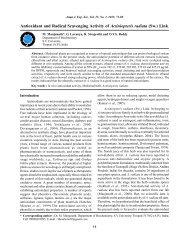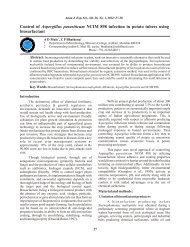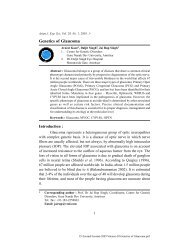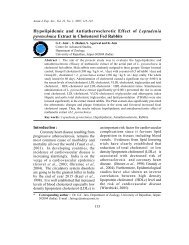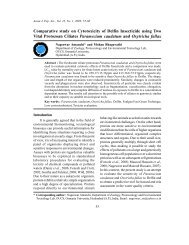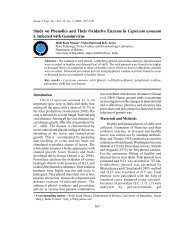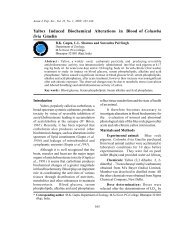Evaluation of the Suspending Properties of Cassia tora Mucilage on ...
Evaluation of the Suspending Properties of Cassia tora Mucilage on ...
Evaluation of the Suspending Properties of Cassia tora Mucilage on ...
You also want an ePaper? Increase the reach of your titles
YUMPU automatically turns print PDFs into web optimized ePapers that Google loves.
Mann A.S.. et al. (2007) Asian J. Exp. Sci., 21(1), 63-67<br />
<str<strong>on</strong>g>of</str<strong>on</strong>g> <str<strong>on</strong>g>the</str<strong>on</strong>g>se gums in <str<strong>on</strong>g>the</str<strong>on</strong>g> field <str<strong>on</strong>g>of</str<strong>on</strong>g> paper, textile,<br />
petroleum recovery and pharmaceutical<br />
industries has resulted in an impetus in<br />
India for intensified research <strong>on</strong> new<br />
sources <str<strong>on</strong>g>of</str<strong>on</strong>g> gums and <str<strong>on</strong>g>the</str<strong>on</strong>g>ir modified<br />
products. <str<strong>on</strong>g>Cassia</str<strong>on</strong>g> <str<strong>on</strong>g>tora</str<strong>on</strong>g> mucilage (CTG)<br />
derived from <str<strong>on</strong>g>the</str<strong>on</strong>g> seeds <str<strong>on</strong>g>of</str<strong>on</strong>g> <str<strong>on</strong>g>Cassia</str<strong>on</strong>g> <str<strong>on</strong>g>tora</str<strong>on</strong>g><br />
Linn. is a comm<strong>on</strong> herbaceous annual<br />
occurring weed throughout India. (S<strong>on</strong>i<br />
and Pal 1996). Although, some work had<br />
already been carried out <strong>on</strong> gums as<br />
excipients (Boyinbode and Iranloye 1986;<br />
Odeku et al., 1991; Odeku and Akinlosotu<br />
1997), it seems that no work has been<br />
d<strong>on</strong>e <strong>on</strong> <str<strong>on</strong>g>the</str<strong>on</strong>g> suitability <str<strong>on</strong>g>of</str<strong>on</strong>g> <str<strong>on</strong>g>Cassia</str<strong>on</strong>g> <str<strong>on</strong>g>tora</str<strong>on</strong>g><br />
mucilage as a suspending agent in<br />
sulphadimidine suspensi<strong>on</strong> as compared<br />
to <str<strong>on</strong>g>the</str<strong>on</strong>g> relatively comm<strong>on</strong> natural agents as<br />
Acacia, tragacanth and gelatin, using<br />
sedimentati<strong>on</strong> volume, rheology and<br />
particle size analysis as assessment<br />
parameters. <str<strong>on</strong>g>Cassia</str<strong>on</strong>g> mucilage is safe for<br />
use as a suspending agent in human and<br />
pet foods based <strong>on</strong> <str<strong>on</strong>g>the</str<strong>on</strong>g> levels <str<strong>on</strong>g>of</str<strong>on</strong>g> use <str<strong>on</strong>g>of</str<strong>on</strong>g><br />
<str<strong>on</strong>g>Cassia</str<strong>on</strong>g> mucilage, which are comparable to<br />
<str<strong>on</strong>g>the</str<strong>on</strong>g> use levels <str<strong>on</strong>g>of</str<strong>on</strong>g> o<str<strong>on</strong>g>the</str<strong>on</strong>g>r suspending agents<br />
(Hallaganf et al., 1997).<br />
Sulphadimidine was chosen for this<br />
investigati<strong>on</strong> because it is a typical<br />
representative <str<strong>on</strong>g>of</str<strong>on</strong>g> practically insoluble<br />
drugs which would require a suspending<br />
agent to be prepared as a liquid dosage<br />
form (The British Pharmacutical Codex,<br />
1994).<br />
Materials and Methods :<br />
The materials used include<br />
sulphadimidine (fine powder), gelatin,<br />
benzoic acid BP, and amaranth soluti<strong>on</strong><br />
(Merck, Germany), Acacia gum powder<br />
(Myrt<strong>on</strong> Jaunders and Co. Ltd.,<br />
Liverpool), compound tragacanth powder<br />
64<br />
(Searle Co., England). All solvents used<br />
were <str<strong>on</strong>g>of</str<strong>on</strong>g> analytical grade<br />
<str<strong>on</strong>g>Cassia</str<strong>on</strong>g> <str<strong>on</strong>g>tora</str<strong>on</strong>g> mucilage was isolated<br />
from seeds as per <str<strong>on</strong>g>the</str<strong>on</strong>g> method described<br />
by (S<strong>on</strong>i and Pal, 1996). The seed sample<br />
had earlier been identified and<br />
au<str<strong>on</strong>g>the</str<strong>on</strong>g>nticated in <str<strong>on</strong>g>the</str<strong>on</strong>g> herbarium<br />
Department <str<strong>on</strong>g>of</str<strong>on</strong>g> Botany, Dr. H. S. Gour<br />
University Sagar (M.P). The gum was<br />
dried at 50o C for 8 hr, pulverized using<br />
blender hydrated in double strength<br />
chlor<str<strong>on</strong>g>of</str<strong>on</strong>g>orm water for 5 days with<br />
intermittent stirring, <str<strong>on</strong>g>the</str<strong>on</strong>g>n strained through<br />
a piece <str<strong>on</strong>g>of</str<strong>on</strong>g> calico cloth. The gum was<br />
precipitated from soluti<strong>on</strong> using acet<strong>on</strong>e.<br />
The precipitated gum was filtered, washed<br />
with diethyl ei<str<strong>on</strong>g>the</str<strong>on</strong>g>r, and <str<strong>on</strong>g>the</str<strong>on</strong>g>n dried in a hot<br />
air oven at 40oC. The dried mass was<br />
powdered and stored in an airtight<br />
c<strong>on</strong>tainer. 1%w/v soluti<strong>on</strong> <str<strong>on</strong>g>of</str<strong>on</strong>g> <str<strong>on</strong>g>the</str<strong>on</strong>g> crude<br />
gum in cool distilled water was subjected<br />
to some characterizati<strong>on</strong> tests.<br />
Preparati<strong>on</strong> <str<strong>on</strong>g>of</str<strong>on</strong>g> Sulphadimidine<br />
Suspensi<strong>on</strong>s : Compound tragacanth<br />
powder (0.5 g) and 10 g <str<strong>on</strong>g>of</str<strong>on</strong>g><br />
sulphadimidine were triturated toge<str<strong>on</strong>g>the</str<strong>on</strong>g>r<br />
with 20 ml <str<strong>on</strong>g>of</str<strong>on</strong>g> Raspberry syrup to form a<br />
smooth paste. Benzoic acid soluti<strong>on</strong> (2<br />
ml) and 1 ml <str<strong>on</strong>g>of</str<strong>on</strong>g> amaranth soluti<strong>on</strong> were<br />
added gradually with c<strong>on</strong>stant stirring and<br />
<str<strong>on</strong>g>the</str<strong>on</strong>g>n mixed with 50 ml <str<strong>on</strong>g>of</str<strong>on</strong>g> chlor<str<strong>on</strong>g>of</str<strong>on</strong>g>orm<br />
water double strength. The mixture was<br />
transferred into a 100 ml amber bottle,<br />
made up to volume with distilled water<br />
and <str<strong>on</strong>g>the</str<strong>on</strong>g>n shaken vigorously for 2 min<br />
(thus making 0.5% w/v <str<strong>on</strong>g>of</str<strong>on</strong>g> <str<strong>on</strong>g>the</str<strong>on</strong>g> gum in <str<strong>on</strong>g>the</str<strong>on</strong>g><br />
preparati<strong>on</strong>). The procedure was repeated<br />
using 1.0, 1.5, 2.0, 2.5, 3.0, 3.5 and 4.0%<br />
w/v <str<strong>on</strong>g>of</str<strong>on</strong>g> compound tragacanth powder. The<br />
above procedure was repeated with<br />
Acacia gum, gelatin and <str<strong>on</strong>g>Cassia</str<strong>on</strong>g> <str<strong>on</strong>g>tora</str<strong>on</strong>g> gum.



